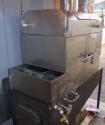Engineer here with a background in fluid dynamics. I had the same thought... I would be surprised if Reynolds number there is greater than 2000, let alone if the sap is even flowing at full-pipe? I'm not disputing the experimental results, but I wonder if the turbulence/friction hypothesis is correct. Did the internal flow radius alone produce increased sap yields, or was it the barbs at the tip of the tap as well? Reducing turbulence and friction has a nice marketing ring to it, I'm just not sure that's the actual mechanism.
One way to test it might be to diagonally insert a thin metal tube into the tap-hole from above the fitting and measure the delta-P across the Arc-Flow fitting during sap-flow event. Compare this to a similar measurement on a standard right-angle tap. You would probably want to measure the sap flow during these tests as well to get dP-vs-Q for each.
Edit: I just saw the youtube videos of the 5 different configurations, and the qualitative differences are clear. I just wonder how much those differences affect the vacuum level in the tap-hole. Also if the flow rates shown are prototypical for sap flow.














 Reply With Quote
Reply With Quote

 Turbulence would seem to me to be the proper term...would you suggest another?
Turbulence would seem to me to be the proper term...would you suggest another?
